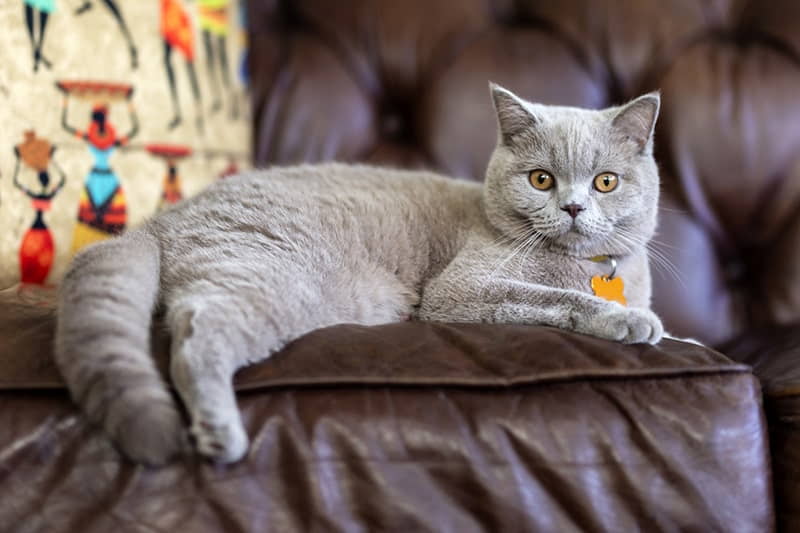Information for pet owners on traits, history, caring for their animals, and other subjects
You’ll be captivated by the British Shorthair’s friendly personality and rounded looks right away. This is one of the oldest English cat breeds, and because to his easygoing nature, he has become popular both in Britain and elsewhere.
The British Shorthair cat has almost totally round features, including a round head, round paws, round paw tips, round cheeks, and a round tail. These cats can have a variety of coat colors, but one of the most popular is the striking blue shade. This breed has occasionally been referred to as the British Blue. Although the British Longhair has a longer coat, all of its traits remain the same. Only a few cat registries recognize British Longhair cats as a separate breed.

Breed Overview
- WEIGHT: 7 to 17 pounds; males are typically larger than females
- LENGTH: 22 to 25 inches
- COAT: Short and dense
- COAT COLOR: Colors include solid white, black, red, cream, and blue (most common), also bi-color, tabby, calico, smoke, and shaded varieties.
- EYE COLOR: Copper, green, gold, blue, odd-eyed
- LIFE EXPECTANCY: 12 to 16 years
Characteristics of the British Shorthair
| Affection Level | Low |
| Friendliness | Medium |
| Kid-Friendly | Medium |
| Pet-Friendly | Medium |
| Exercise Needs | Low |
| Playfulness | Low |
| Energy Level | Low |
| Intelligence | Medium |
| Tendency to Vocalize | Low |
| Amount of Shedding | Medium |

History of the British Shorthair
One of the oldest cat breeds in England, the British Shorthair has Roman origins. In order to protect their food supply from rats during the time when their empire was expanding, it appears that cats were carried with the Roman armies when they invaded England. The cats established themselves in the area and continued to live as common street cats for ages.
In the late 1800s, a British man by the name of Harrison Wier was the first cat breeder. Through a breeding scheme and intentional crossbreeding, he is credited with domesticating the normal British street cat and creating the British Shorthair cat that we are familiar with today.
The breed was close to extinction during the difficult economic times of World War II. The remaining bloodlines were combined with various breeds, including the Domestic Shorthair, Russian Blue, and Persian types, to ensure their survival after the war.
British Shorthairs were initially recognized as a breed in 1967 by the American Cat Association. Other organizations followed suit, such as the International Cat Association in 1979 and the Cat Fanciers Association in 1980.

British Shorthair maintenance
These felines are sociable, happy, and simple to care for. When it comes to grooming or care, the British Shorthair is not a breed that is particularly demanding or boisterous.
The breed possesses the thickest and plushest short hair of any cat breed, with more hair per square inch. Numerous weekly brushes for your cat will assist to remove loose hairs and dander and prevent hairballs. Since these cats will shed their winter coats more furiously in the spring, you might need to brush them more frequently.
The majority of pet owners believe that the British Shorthair cat matures from a cheerful kitten into a stately yet amiable adult cat. Don’t expect them to grow to their full size straight away, though. Although most British Shorthair cats reach their adult size by the age of three, some don’t until they are five years old. These cats typically like the company of their human family members and will regularly spend time playing or relaxing in the same room, even if they won’t always leap onto your lap or enjoy being carried or handled.
Because they are vertically challenged and have low energy needs, British Shorthairs are not known for leaping onto counters or other high perches. It’s actually a good idea to play with your cat on a regular basis for his welfare and mental stimulation because of this predisposition for inactivity. Since they can be happy on their own, they can survive being left alone at home for an extended period of time without having separation anxiety.
As long as they have their own space, these cats are likely to be accommodating and patient if you have children or other pets in the house. Keep other animals away from this honorable cat and instruct children not to carry or hold your cat against their will.
It’s interesting to know that the Cheshire Cat in Alice in Wonderland was modeled after the British Shorthair. The striking grin and wise personality of this breed set it apart.
Common Health Problems
Because of a large genetic pool, the British Shorthair is a healthy breed that isn’t well known for having many genetic problems. However, they can be prone to Hemophilia B, a hereditary bleeding disorder. Breeders of dogs can examine the DNA of their cats to see whether they are disease carriers.
Keep the British Shorthair from putting on too much weight. Although these cats are robust and muscular, they shouldn’t gain weight. They may need to be encouraged to move by providing them with engaging toys and energetic activity.
Food intake and diet
Like all cats, the British Shorthair benefits from a balanced diet created with premium ingredients. Feed your cat in accordance with his age, degree of activity, and energy requirements.
Even though these cats typically don’t make a big deal out of begging and lack the energy to jump up onto counters or tables, it’s best to prevent the development of undesirable habits by avoiding feeding them food from your plate while you’re eating.
Breeds of Cats Not Listed Here and More Research
The British Shorthair is a particularly popular cat breed because of its laid-back personality and independent nature. Not everyone should choose it, especially if they want a lap cat that is constantly vying for their attention. Consider the temperament and maintenance requirements of this breed carefully before deciding to bring a new furry family member home. If you do, you’ll get a loyal, honorable pet to enjoy for a very long time.
The following similar breeds may pique your interest:
- Russian Highland Fold in Siam
READ NEXT: Birman: Cat Breed Profile

